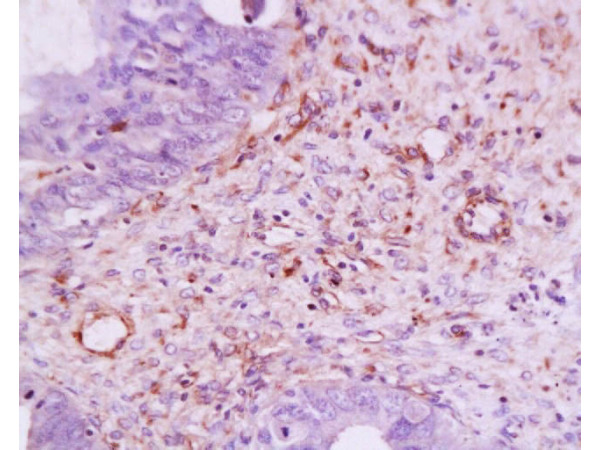VEGF antibody
GTX20119
ApplicationsWestern Blot, ELISA
Product group Antibodies
TargetVEGFA
Overview
- SupplierGeneTex
- Product NameVEGF antibody [VG76e]
- Delivery Days Customer9
- Application Supplier NoteGood results have been reported on human, bovine and porcine paraffin sections, but only after microwave treatment and using Tris HCl pH 10 buffer (NOT citrate buffer).VEGF-A is a hetero dimer, consisting of 2 chains of approximately 24kDa each.
- ApplicationsWestern Blot, ELISA
- CertificationResearch Use Only
- ClonalityMonoclonal
- Concentration1.3 mg/ml
- ConjugateUnconjugated
- Gene ID7422
- Target nameVEGFA
- Target descriptionvascular endothelial growth factor A
- Target synonymsMVCD1; vascular endothelial growth factor A; vascular endothelial growth factor A121; vascular endothelial growth factor A165; vascular permeability factor; VEGF; VPF
- HostMouse
- IsotypeIgG1
- Protein IDP15692
- Protein NameVascular endothelial growth factor A
- Scientific DescriptionThis gene is a member of the PDGF/VEGF growth factor family. It encodes a heparin-binding protein, which exists as a disulfide-linked homodimer. This growth factor induces proliferation and migration of vascular endothelial cells, and is essential for both physiological and pathological angiogenesis. Disruption of this gene in mice resulted in abnormal embryonic blood vessel formation. This gene is upregulated in many known tumors and its expression is correlated with tumor stage and progression. Elevated levels of this protein are found in patients with POEMS syndrome, also known as Crow-Fukase syndrome. Allelic variants of this gene have been associated with microvascular complications of diabetes 1 (MVCD1) and atherosclerosis. Alternatively spliced transcript variants encoding different isoforms have been described. There is also evidence for alternative translation initiation from upstream non-AUG (CUG) codons resulting in additional isoforms. A recent study showed that a C-terminally extended isoform is produced by use of an alternative in-frame translation termination codon via a stop codon readthrough mechanism, and that this isoform is antiangiogenic. Expression of some isoforms derived from the AUG start codon is regulated by a small upstream open reading frame, which is located within an internal ribosome entry site. [provided by RefSeq, Nov 2015]
- Storage Instruction-20°C or -80°C,2°C to 8°C
- UNSPSC12352203
References
- Trop2 Guarantees Cardioprotective Effects of Cortical Bone-Derived Stem Cells on Myocardial Ischemia/Reperfusion Injury. Li T et al., 2018 Aug, Cell TransplantRead more
- CHC promotes tumor growth and angiogenesis through regulation of HIF-1alpha and VEGF signaling. Tung KH et al., 2013 Apr 30, Cancer LettRead more



![IHC-P analysis of human liver carcinoma tissue using GTX83425 VEGFA antibody [4G3].](https://www.genetex.com/upload/website/prouct_img/normal/GTX83425/GTX83425_1356_IHC-P_w_23061419_454.webp)
